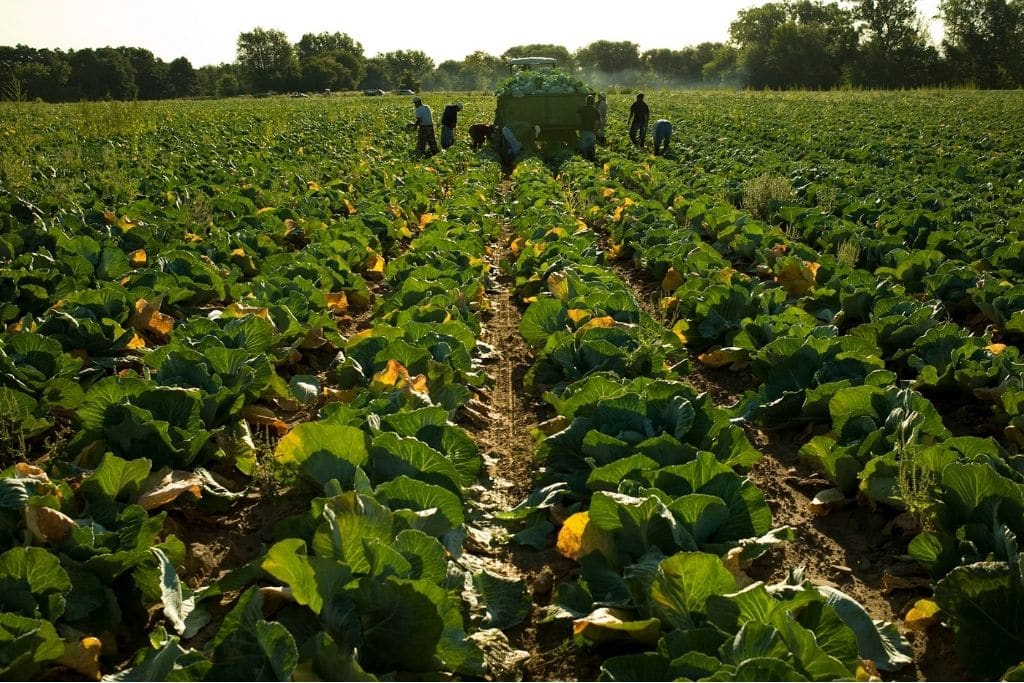A recent report released by WWF-UK and Tesco in 2021 found that global food waste on farms amounted to 1.2 billion tonnes per year, approximately 15.3% of the food produced globally. This measures up to USD$370 million of food wasted on farms. 58% of this waste occurs in high- and middle- income countries of Europe, North America, and industrialised Asia, despite these countries having higher farm mechanisations and only 37% of the global population. 4.4 million square kilometres of land is used to grow food which is then wasted on farms per year, larger than the entire Indian subcontinent. When these statistics are viewed alongside with the recent findings reported by the Food Waste Index, which reported that 17% of food is wasted from retail to consumer stages of the supply chain, it suggests that significantly more than one third of the total food produce is wasted, possibly up to 40%. Food that was unharvested due to reasons such as the inability of farmers to fund harvesting labourers or market-based specifications not being included in these estimations, result in an underestimate of the true amounts of food waste on farms.
—
Food waste begins right at the first stage of the supply chains: on the farms. This waste is caused by multiple direct and indirect factors. One major direct driver cannot entirely be controlled is biological and environmental factors. Crops can be damaged by pests and other diseases and factors linked to the weather, climate, soil, water availability, extreme weather events and natural disasters.
Poor technology and infrastructure is another direct contributor of food waste due to reasons such as inadequate storage for harvested produce, poor harvesting technology, lack of temperature management of produce at harvest, and inappropriate fishing gear and lack of chilling of landed catch. Without adequate storage of perishable produce, farmers are forced to sell regardless of market prices, or risk they waste.
Factors linked to decisions at the farm stage, such as poor harvesting and handling techniques, judgment of crop maturation, and timing of harvest, are also direct contributors. Within animal agriculture, drivers of waste include poor sanitation during milking which leads to diseases, poor standards of animal husbandry leading to high mortality rates, and fishing techniques that result in significant discards. However, through technological, financial, and education investment, food waste from these factors can be effectively reduced.
On a larger scale, these direct drivers are often influenced indirectly by socio-economic and market factors that shape the agriculture sector. Market factors such as market structure, the regulations and standards in place, access to finance that farmers have, and fair trade and contractual agreements are wider influences involving actors and agencies that impact the amount of food waste occurring, something which farmers and farm-stage interventions have no control over.
Supermarkets have also been found to play a visible and systematic role in the overproduction, and consequently, the waste of food on farms around the world. A report by Feedback, an environmental organisation that campaigns for the end of food waste at every level of the supply chain, investigated international supply chains and found that suppliers to UK supermarkets are forced to throw away large amounts of food for aesthetic reasons.
Supermarkets impose strict cosmetic specifications to farmers and only buy produce that fit size, shape, and colour specifications regardless of its nutrition, taste, and value. While some farmers reported no waste due to this practice, 7.4% of respondents reported their crops were not sold to the market and had a loss of up to 40% due to these standards. Their survey also found that four out of 10 farmers said that “retailers use cosmetic standards as an excuse to reject produce when they can get a lower price elsewhere or their demand has fallen.”
Overproduction is a normalised aspect for supplying producers, which has become a large driver of food waste at farmer level as farmers feel the need to overproduce to hedge against risk and ensure they can supply supermarkets. Feedback’s survey found that six out of 10 farmers reported overproducing due to pressure to always meet buyer order or risk losing contracts. This results in supply exceeding demand when there is good weather and abundant crops. This issue is especially evident in local seasonal produce, which supermarkets fail to market, as with the case in the UK in 2017 when there was a cauliflower glut, causing large amounts of the vegetable to go to waste and led several supermarkets to slash prices.
You might also like: How Does Food Waste Affect the Environment?
Cancelled or altered orders are also found to be a significant driver of waste, with eight out of 10 farmers reporting that retailers change the proportion of stock bought from suppliers to find the cheapest offer, resulting in unpredictable demand. Last minute order cancellations make it difficult to find alternative buyers for produce before it deteriorates.
The UK’s food retail market is one of the most concentrated in Europe and nearly half of the respondents reported that the concentration of power among the supermarkets has led to less outlets, such as local grocers, for surplus produce.
At a global level, Sustainable Development Goal (SDG) 12 aims to develop sustainable consumption and production patterns with the target of cutting food waste and loss in half by 2030. Reaching this target will require innovative approaches and the 2020 No Food Left Behind convening, held by the World Wildlife Fund (WWF), saw the development of interventions that could reduce on-farm produce loss and surplus.
The first tool to achieve this is a ‘Food Loss Measurement Tool Implementation and Amplification’. Measure is a first step in unlocking opportunities to reduce waste, financial gain, and food utilisation. These opportunities include utilising surplus for value-add-processing, identifying surplus to sell through new channels, improving forecasting for future planting, and then reducing total planted crops. This tool serves as a foundation and a necessary predecessor for two different interventions: Whole Crop Contracts and Maximising Imperfect and Surplus Products through E-Commerce Distribution. As mentioned earlier, retailers tend to purchase produce based on projected demand and strict cosmetic specifications which, along with the fact that farmers overproduce, rarely cover total supply. By offering whole crop contracts, which is a long-term contract that ensures absorption of surplus and edible imperfect crops by the buyer, retailers will utilise a greater proportion of total produce. With whole crop contracting, a possible channel for surplus product that may be absorbed by retailers is e-commerce. This would, again, use up a greater portion of farm produce while also helping retailers meet growing demand for online grocery shopping, which has increased significantly since COVID-19. Altogether, these tools would reduce food waste on farms by absorbing total produce and reducing surplus.
Food waste is a global issue and, in a world where one in nine people go hungry or are undernourished, nearly one third of the food produced goes to waste. Large amounts go to waste during the first stage of the supply chain itself, which are farms. There are multiple drivers of food waste, both on the farm level and on a larger scale. Supermarkets also play a significantly visible role in causing surplus and “imperfect” produce to go to waste on farms. To achieve the Sustainable Development Goal 12 and develop sustainable consumption and production, it is important to come together and reduce this waste through developing innovative interventions.


















